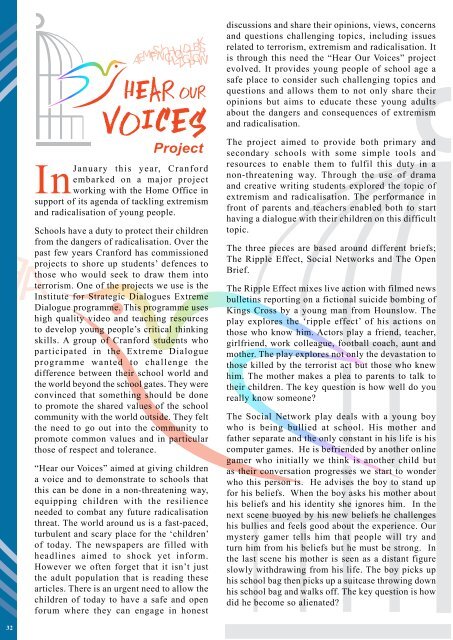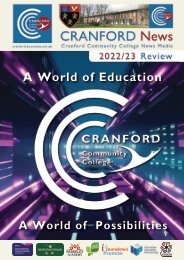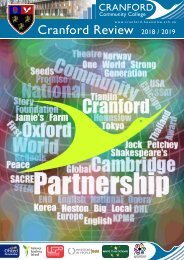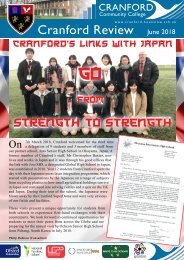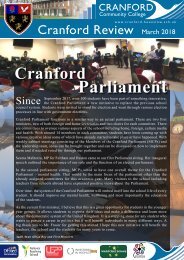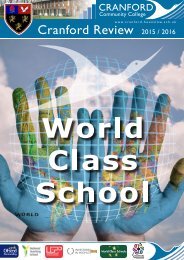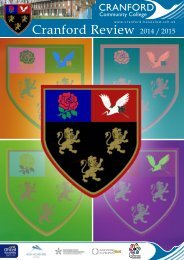Cranford Review 2017
The “Cranford Review” © is a publication of Cranford Community College. Is an annual high standard produced magazine which provides an archive document highlighting various aspects of the life of the academy, its staff, students and community from each academic year. It is a wonderful read and a useful historical document which, with its termly sister publications and occasional special editions, also serves to describe the values of the academy and support the aspirations of the academy, its staff, students and wider community. A colorful layout with a wide range of topics comprising events, extracurricular activities, recognition awards, initiatives, trips and excursions among many others. Hard copies are provided to stakeholders including families, staff, partners, visitors, prospective parents/students, prospective employees and others with an interest or stake in the academy and its students. Headteacher & Director: Kevin Prunty / Editor-in-chief: Jessica Joyce / Graphic Design: Enzo Gianvittorio Danese (Enzo GD) / Printed by: Springfieldpapers.com
The “Cranford Review” © is a publication of Cranford Community College. Is an annual high standard produced magazine which provides an archive document highlighting various aspects of the life of the academy, its staff, students and community from each academic year.
It is a wonderful read and a useful historical document which, with its termly sister publications and occasional special editions, also serves to describe the values of the academy and support the aspirations of the academy, its staff, students and wider community. A colorful layout with a wide range of topics comprising events, extracurricular activities, recognition awards, initiatives, trips and excursions among many others. Hard copies are provided to stakeholders including families, staff, partners, visitors, prospective parents/students, prospective employees and others with an interest or stake in the academy and its students.
Headteacher & Director: Kevin Prunty / Editor-in-chief: Jessica Joyce / Graphic Design: Enzo Gianvittorio Danese (Enzo GD) / Printed by: Springfieldpapers.com
You also want an ePaper? Increase the reach of your titles
YUMPU automatically turns print PDFs into web optimized ePapers that Google loves.
discussions and share their opinions, views, concerns<br />
and questions challenging topics, including issues<br />
related to terrorism, extremism and radicalisation. It<br />
is through this need the “Hear Our Voices” project<br />
evolved. It provides young people of school age a<br />
safe place to consider such challenging topics and<br />
questions and allows them to not only share their<br />
opinions but aims to educate these young adults<br />
about the dangers and consequences of extremism<br />
and radicalisation.<br />
Project<br />
In<br />
January this year, <strong>Cranford</strong><br />
embarked on a major project<br />
working with the Home Office in<br />
support of its agenda of tackling extremism<br />
and radicalisation of young people.<br />
Schools have a duty to protect their children<br />
from the dangers of radicalisation. Over the<br />
past few years <strong>Cranford</strong> has commissioned<br />
projects to shore up students’ defences to<br />
those who would seek to draw them into<br />
terrorism. One of the projects we use is the<br />
Institute for Strategic Dialogues Extreme<br />
Dialogue programme. This programme uses<br />
high quality video and teaching resources<br />
to develop young people’s critical thinking<br />
skills. A group of <strong>Cranford</strong> students who<br />
participated in the Extreme Dialogue<br />
programme wanted to challenge the<br />
difference between their school world and<br />
the world beyond the school gates. They were<br />
convinced that something should be done<br />
to promote the shared values of the school<br />
community with the world outside. They felt<br />
the need to go out into the community to<br />
promote common values and in particular<br />
those of respect and tolerance.<br />
“Hear our Voices” aimed at giving children<br />
a voice and to demonstrate to schools that<br />
this can be done in a non-threatening way,<br />
equipping children with the resilience<br />
needed to combat any future radicalisation<br />
threat. The world around us is a fast-paced,<br />
turbulent and scary place for the ‘children’<br />
of today. The newspapers are filled with<br />
headlines aimed to shock yet inform.<br />
However we often forget that it isn’t just<br />
the adult population that is reading these<br />
articles. There is an urgent need to allow the<br />
children of today to have a safe and open<br />
forum where they can engage in honest<br />
The project aimed to provide both primary and<br />
secondary schools with some simple tools and<br />
resources to enable them to fulfil this duty in a<br />
non-threatening way. Through the use of drama<br />
and creative writing students explored the topic of<br />
extremism and radicalisation. The performance in<br />
front of parents and teachers enabled both to start<br />
having a dialogue with their children on this difficult<br />
topic.<br />
The three pieces are based around different briefs;<br />
The Ripple Effect, Social Networks and The Open<br />
Brief.<br />
The Ripple Effect mixes live action with filmed news<br />
bulletins reporting on a fictional suicide bombing of<br />
Kings Cross by a young man from Hounslow. The<br />
play explores the ‘ripple effect’ of his actions on<br />
those who know him. Actors play a friend, teacher,<br />
girlfriend, work colleague, football coach, aunt and<br />
mother. The play explores not only the devastation to<br />
those killed by the terrorist act but those who knew<br />
him. The mother makes a plea to parents to talk to<br />
their children. The key question is how well do you<br />
really know someone?<br />
The Social Network play deals with a young boy<br />
who is being bullied at school. His mother and<br />
father separate and the only constant in his life is his<br />
computer games. He is befriended by another online<br />
gamer who initially we think is another child but<br />
as their conversation progresses we start to wonder<br />
who this person is. He advises the boy to stand up<br />
for his beliefs. When the boy asks his mother about<br />
his beliefs and his identity she ignores him. In the<br />
next scene buoyed by his new beliefs he challenges<br />
his bullies and feels good about the experience. Our<br />
mystery gamer tells him that people will try and<br />
turn him from his beliefs but he must be strong. In<br />
the last scene his mother is seen as a distant figure<br />
slowly withdrawing from his life. The boy picks up<br />
his school bag then picks up a suitcase throwing down<br />
his school bag and walks off. The key question is how<br />
did he become so alienated?<br />
32


